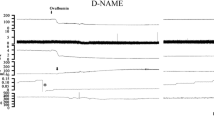Summary
Different mediators such as histamine, leukotrienes, prostaglandins and bradykinin are involved in different reaction mechanisms such as cytotropic anaphylaxis (CA), immune complex anaphylaxis (ICA), reactions due to direct histamine liberation or activation of the complement system or hyperosmolarity induced anaphylactoid reactions.
In the monkey CA induces systemic vasodilatation, a transient pulmonary hypertension and increase of cardiac output followed by peripheral blood pooling and depression of cardiac output. ICA induces peripheral vasoconstriction, a severe increase in pulmonary vascular resistance and decreased cardiac output, the latter possibly being partially due to decreased cardiac contractility.
In hypersensitivity reactions in man cutaneous vasodilatation as well as vasoconstriction may occur alternatively. Peripheral blood pooling and increased vascular permeability are the cause of severe relative and absolute hypovolemia, respectively. Pulmonary vasoconstriction seems to occur in connection with serious bronchospasm. Decreased venous return, myocardial ischemia and hypoxemia can contribute to a reduction of cardiac performance. The most frequent changes in the ECG are sinus tachycardia, sinus bradycardia, extrasystoles, conduction disturbances as A-V block and bundle branch block; lethal or sublethal shock is often associated with malign arrhythmias or cardiac arrest.
Almost normal blood gas values are seen in anaphylactic shock without clinical signs of respiratory obstruction. The very few documented cases of anaphylactic shock with respiratory obstruction indicate that increased airway resistance and reduced lung compliance may be present as well as mild to moderate hypoxemia with normal or subnormal CO2 values.
Zusammenfassung
Verschiedene Mediatoren wie Histamin, Leukotriene, Prostaglandine und Bradykinin sind an der Auslösung verschiedener Reaktionsmechanismen beteiligt, wie zytotrope Anaphylaxie (ZA), Immunkomplex-Anaphylaxie (IKA), Reaktionen infolge direkter Histaminfreisetzung oder Komplementaktivierung oder das durch Hyperosmolarität induzierte anaphylaktische Syndrom.
Am Affen bewirkt ZA eine systemische Vasodilatation, vorübergehend eine pulmonale Hypertonie und eine vermehrte Herzauswurfleistung, gefolgt von peripherer Blutsequestration und verminderter Herzauswurfleistung. IKA bewirkt eine periphere Vasokonstriktion, einen ausgesprochenen Anstieg des pulmonalen Gefäßwiderstandes und eine verminderte Herzauswurfleistung; letztere ist möglicherweise partiell auf eine verminderte Herzkontraktilität zurückzuführen.
Bei Überempfindlichkeitsreaktionen des Menschen treten alternativ sowohl kutane Vasodilatation als auch Vasokonstriktion auf. Periphere Blutsequestration und erhöhte Gefäßpermeabilität sind die Ursache schwerer relativer bzw. absoluter Hypovolämie. Pulmonale Vasokonstriktion scheint im Zusammenhang mit schwerem Bronchospasmus aufzutreten. Verminderter Blutrückfluß, Myokardischämie und Hypoxämie können zu einer Verminderung der Herzleistung beitragen. Die häufigsten Veränderungen im EKG sind Sinustachykardie, Sinusbradykardie, Extrasystolen, Leitungsstörungen wie A-V-Block und Schenkelblock; lethale bzw. sublethale Schockzustände treten oft mit malignen Arrhythmien oder Herzstillstand auf.
Beinahe normale Blutgaswerte werden beim anaphylaktischen Schock ohne klinische Zeichen einer respiratorischen Obstruktion beobachtet. Die wenigen dokumentierten Fälle von anaphylaktischem Schock mit respiratorischer Obstruktion zeigen das mögliche Vorliegen eines erhöhten Luftwegwiderstandes und einer verminderten Lungencompliance an, sowie eine leichte bis mittelschwere Hypoxämie mit normalen oder subnormalen CO2-Werten.
Similar content being viewed by others
References
Czarny D, Prichard PJ, Fennessy M, Lewis S (1980) Anaphylactoid reaction to 50% solution of dextrose. Med J Australia 2:255–258
Fisher M.McD, Dicks I (1979) Volume replacement in acute anaphylactoid reactions. Anaesth Intens Care 7:375–376
Hedin H, Kraft D, Richter W, Scheiner O, Devey M (1979) Dextrane reactive antibodies in patients with anaphylactoid reactions to dextran. Immunobiology 156:289–290
Kazimierczak W, Diamant B (1978) Mechanisms of histamine release in anaphylactic and anaphylactoid reactions. Progr Allergy 24:295–365
Lecomte J (1957) Liberation of endogenous histamine in man. J Allergy 28:102–112
Lorenz W, Doenicke A, Messmer K, Reimann JH, Thermann M, Lahn W, Beer J, Schmal A, Dormann P, Regenfuss P, Hamelmann H (1976) Histamine release in human subjects by modified gelatin (Haemaccel) and dextran. Brit J Anaesth 48:151–165
Pavek K (1977) Anaphylactic shock in the monkey: its hemodynamics and mediators. Acta Anaesth Scand 21:293–307
Pavek K, Wegmann A (1981) Pathophysiologie des anaphylaktischen und anaphylaktoiden Schocks. Eine kooperative, retrospektive Studie. Fortschr Med 99:1994–1999
Ring J (1978) Anaphylaktoide Reaktionen. Anaesth Intens Care 111
Sheffer AL, Austen KF (1980) Exercise-induced anaphylaxis. J Allergy Clin Immunol 66:106–111
Smedegård G (1980) Anaphylactic shock. Acta Universitatis Upsaliensis. Dissertation 548
Smith PL, Kagey-Sobotka A, Bleecker ER, Traystman R, Kaplan AP, Gralnick H, Valentine MD, Permutt S, Lichtenstein LM (1980) Physiologic Manifestations of Human Anaphylaxis. J Clin Invest 66:1072–1080
Waldhausen E, Marquardt B, Helms U (1981) Erfahrungen aus 31 anaphylaktoiden Reaktionen. Anaesthesist 30:47–51
Wegmann A, Renker H (1976) Das Elektrokardiogramm im anaphylaktischen Schock des Menschen. Klin Wochenschr 54:453–459
Author information
Authors and Affiliations
Rights and permissions
About this article
Cite this article
Pavek, K., Wegmann, A., Nordström, L. et al. Cardiovascular and respiratory mechanisms in anaphylactic and anaphylactoid shock reactions. Klin Wochenschr 60, 941–947 (1982). https://doi.org/10.1007/BF01716952
Issue Date:
DOI: https://doi.org/10.1007/BF01716952




